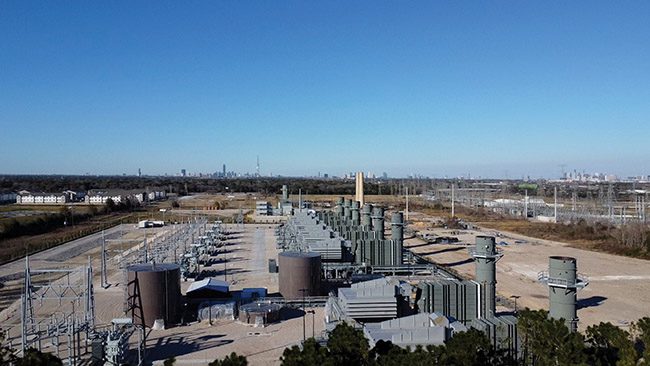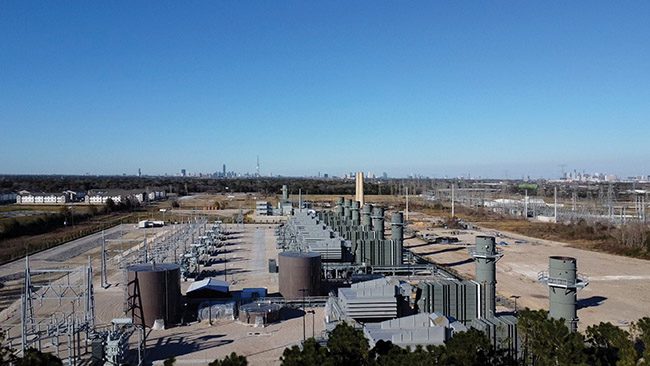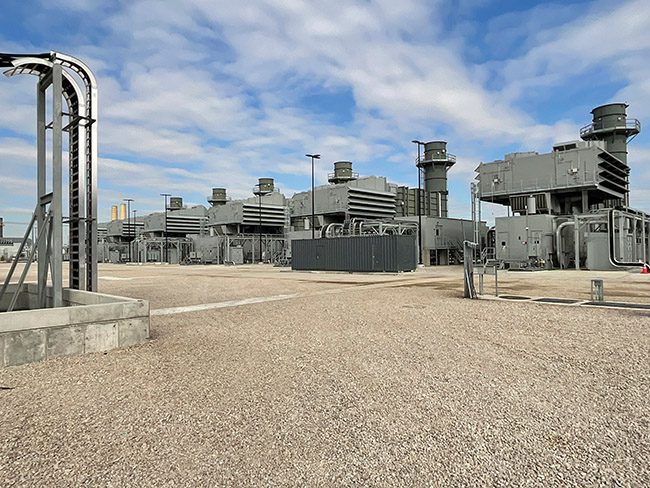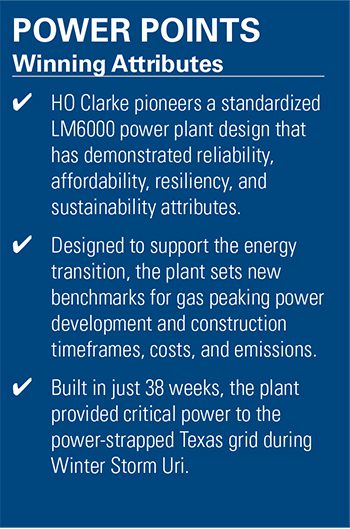A New Breed of Energy Security: HO Clarke Power Plant


WattBridge, a relatively new independent power producer that evolved out of a non-OEM aeroderivative gas turbine solutions provider, completed its first power facility based on a standardized LM6000 plant design in January 2021, just weeks ahead of Winter Storm Uri. The design has been replicated in an expanding 2.3-GW fleet purpose-built to furnish the volatile Texas grid with crucial peaking power.
Electricity peaking plants, sometimes called peak-lopping plants, have existed since the inception of the interconnected grid, helping to balance the fluctuating power requirements of the electricity grid. As the energy transition has accelerated, bringing with it a massive influx of non-dispatchable variable generation from renewables, more emphasis has grown on the value of flexibility, from minute-to-minute, hour-to-hour, and season-to-season.
In 2018, that value became more critical within the Electric Reliability Council of Texas (ERCOT). The grid operator that serves 90% of Texas warned it was struggling to expand to the summer reserve margin. While the wholesale energy market had seen a proliferation of wind and solar resources-and even recently added a reliability risk desk to closely monitor and respond to wind and solar forecast errors, net load ramps, inertia levels, and ancillary service needs-its summer reserve margin had fallen dramatically to 11%, well below its target of 13.5%. ERCOT pointed to a spate of recent plant retirements, including major coal baseload generators, for the tight operating conditions.
PROENERGY, a Sedalia, Missouri-based integrated energy service solutions provider, sensed an opportunity. The company has painstakingly built its capabilities in power plant construction, equipment repair, overhaul services, outage response, and turnkey plant operation solutions since its founding in 2002 by President and CEO Jeff Canon. Today, PROENERGY employs more than 500 professionals, has a global experience footprint covering 40 countries, and specializes in services for the LM6000 and LM2500 platforms. Canon, an industry veteran, is specifically fluent in the capabilities of LM6000 aeroderivative gas turbines, owing to his deep experience at some of the nation's iconic power plants, including as plant manager at Pasco County Cogeneration Facility in Dade City, Florida. POWER recognized that facility as a Top Plant in 1994 for installing the world's first two GE LM6000 aeroderivative gas turbines.
LM6000PC technology, which now has the benefit of three decades of operational experience, is a quick-start, highly efficient technology that is ideally suited to support renewable balancing, Canon told POWER in September. Derived from GE's CF6-80C2 high bypass turbofan aircraft engine, the 46.1-MW simple-cycle, two-shaft turbine is still one of the most fuel-efficient in its size class.
Sensing an OpportunityIn 2018, however, though cost and market conditions were optimal, a standardized LM6000 power plant package was not available. To fill the market gap, PROENERGY designed a fully engineered and standardized modular peaking plant that could be delivered turnkey and perform reliably with an absolute cost advantage. It rolled out the solution, PowerFLX," in 2018, furnishing customers with a single source point-from inception through commercial operation-for building out PowerFLX plants. At the same time, it established a dedicated power generating company, WattBridge, to develop, own, and operate PowerFLX plants. PROENERGY tasked Mike Alvarado, a longtime power plant developer, with leading initial WattBridge opportunities in ERCOT.
 |
1. HO Clarke I has six LM6000PC units with a combined capacity of 288-MW. Courtesy: PROENERGY |
While WattBridge isn't tied to a single technology," its mission is to accelerate a reduced carbon energy future. We have the capabilities, resources, and technical expertise to deliver," Alvarado told POWER. The company's most lucrative draw as the transition accelerates and in a cutthroat market like ERCOT is this really tremendous cost advantage that existed, born out of a pretty unique business model within PROENERGY," he said.
The PROENERGY cost advantage leverages a full integration, Canon explained. Unlike a lot of independent power producers who don't build or operate their own plants, PROENERGY buys raw steel to build packages," he said. We actually overhaul the engines ourselves. We have our own repair shops." PROENERGY, which is not an original equipment manufacturer (OEM), even repurposes machines. These turbines from Pasco, where Canon previously served as plant manager, were purchased by PROENERGY and placed in the WattBridge fleet.
The full integration also pans out to be a major plant development benefit, Alvarado said. I think PROENERGY is arguably the expert in the world in this technology, both from an equipment standpoint, but also an operation and maintenance and [engineering, procurement, and construction (EPC)] standpoint," he said. The WattBridge underlying mission is to follow the market in a reliable, cost-effective, and ultimately a responsible way," is also a big draw. Investors value responsibility, he noted, and the WattBridge gas power offering caters to energy security by bolstering market requirements being born out of [renewable] intermittency."
A 38-Week Construction TimeframeThe unique model and its plant install price, which is significantly less than our competition," provided a crucial opening in the summer of 2019, when ERCOT wholesale power prices spiked, signaling attractive conditions for new builds, Canon said. WattBridge quickly kicked off the development of its first plant, HO Clarke, a 288-MW peaker in Houston that would be equipped with six LM6000PC units, running at average heat rate of 9,725 Btu/kW. Canon said the primary motivation for PROENERGY to build the plant was to provide a physical showplace for our product, looking at it as a fully integrated business." However, its economics are also sound, even while running at an 11.7% capacity factor in its first year, which has increased sharply in 2022. From a market perspective, we have heat rate call options on the facility, so that underpins the economics," Canon said.
While the project achieved financial close in December 2019, it received its construction permit in March 2020. That was the beginning of COVID [disruptions]," recalled Alvarado. And effectively, what the City of Houston did was convert permitted operations to a remote situation. That slowed us down." Still, the company spearheaded construction in earnest, and by December 2020-within 38 weeks-it was ready for commissioning.
That gives you a sense of the value of this business model," Alvarado said. It's just a very compelling advantage that we have in the industry. Timelines in the industry are typically closer to 18 to 24 months if you are doing it in a more traditional procurement way."
A Powerhouse During Winter Storm UriThe plant's commercial operation in January 2021 came at a crucial time. In mid-February, Winter Storm Uri unleashed its deadly three-day, statewide freeze, disabling an average 34 GW of generation-nearly half of ERCOT's all-time winter peak. The newcomer plant remained steadfast on the grid, with all six units providing 141 hours of uninterrupted critical power supplies to public safety infrastructure during the storm's critical days. The plant's resilient, weatherized design and its ideal location-on well-established gas infrastructure with firm supply and transport-played an essential role in that achievement.
PROENERGY preparation and expertise was also pivotal, said Alvarado. We are a fast-start peaker generating station, designed to run in exactly these types of situations," he said. Our biggest challenge was keeping our crew fed and sheltered as local hotels closed down within the first 24 hours of the storm. In the end, the crew slept on the control room floor in shifts for five days straight. We are so thankful for their efforts," he recalled.
HO Clarke's significant reliability attributes laid the foundation for several sister plants in the Greater Houston area. In fall 2021, WattBridge brought online two more LM6000PCs as part of the 96-MW HO Clarke II project. WattBridge in late 2019 also kicked off development of the two-phase Topaz facility in Galveston County. The seven-unit 336-MW Topaz I began operating in July 2021, and the three-unit 144-MW Topaz II followed within weeks that summer.
In summer 2022, meanwhile, WattBridge put online the six-unit 288-MW Braes Bayou plant in Fort Bend County. The 288-MW Mark One nearby is currently in the commissioning phase, and the company plans to fully commission its next project, the 288-MW Brotman facility, in early 2023. Recently placed in the construction queue, meanwhile, is the 480-MW Remy Jade, a greenfield project.
According to Alvarado, another 1,696 MW is in advanced stages of development. Overall, we've raised close to $1.75 billion-which is fairly unique in the gas and thermal space in the last few years, just in terms of the amount of capital raised and the number of assets funded, under construction, and coming to commercial operation," Alvarado said.
Sustainability Is ParamountCommitted to accelerating a reduced carbon energy future, WattBridge is also developing utility-scale energy storage at several of the company's natural gas plants, said Alvarado. That's something we've been thoughtful about when we look for locations: reaching a scale and size that that's meaningful, but also enables energy storage," he said. The economics of it are a little bit challenging right now, but it's very much in our plans."
 |
At the same time, PROENERGY has invested $12.3 million (and 10,000 hours of engineering) in a string-test" facility-a unique, plant-level facility that mirrors real-world operating conditions while free from the grid"-that became fully hydrogen-ready in February 2022. The facility, equipped with a 60-MW load bank system, serves as the PROENERGY proving ground" to help expand LM6000PC and PD fuel flexibility and resilience.
The company's ultimate goal is to test aeroderivative package design enhancements and power-augmentation methods while assessing the limits of hydrogen fuel mixes. Tests, which begin in 2022, will start below the established 30% hydrogen mix." The company plans to make incremental increases to a 50% mix, with a long-term goal of a 100% hydrogen burn.
Canon is hopeful tests will initiate the next evolution of the LM6000 platform. By testing these engines with blended and, eventually, green hydrogen fuel, we will broaden the applications of this technology and strengthen its value within a low-carbon economy," he said.
-Sonal Patelis a POWER senior associate editor (@sonalcpatel,@POWERmagazine).
The post A New Breed of Energy Security: HO Clarke Power Plant appeared first on POWER Magazine.